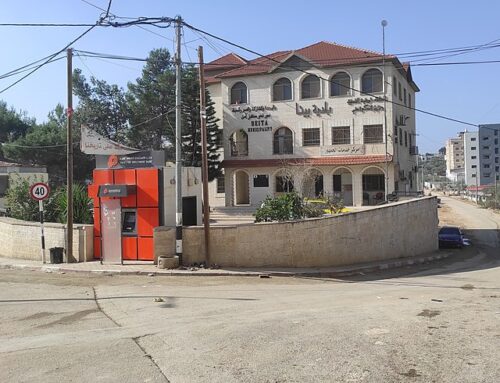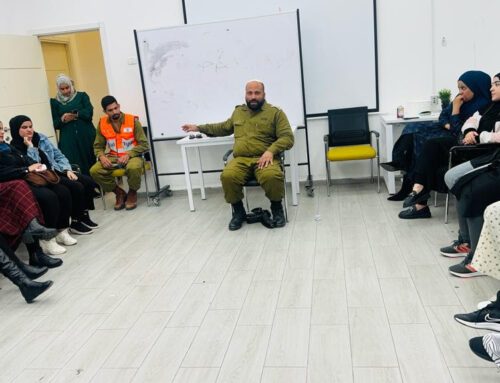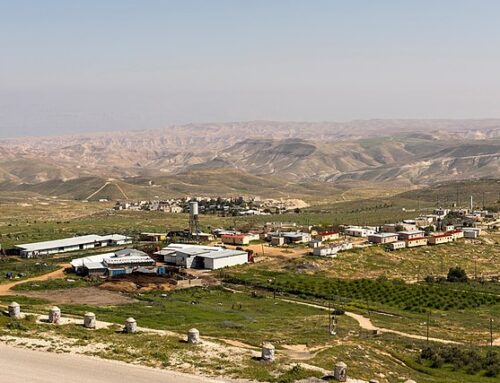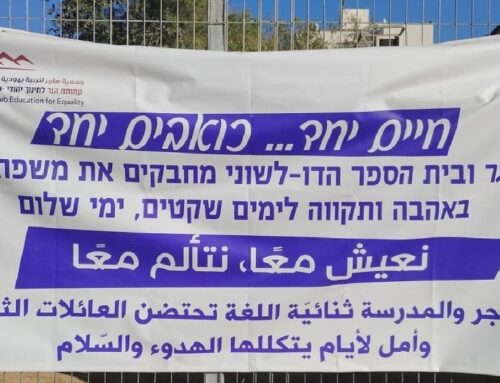 Rabbi Bruce Cohen died on August 3, 2010. A Reform Rabbi, he was the founder and long-time director of Interns For Peace which strove to improve relations between Jews and Arabs in Israel and beyond. Many members of Meretz USA were involved with and supported IFP over the years and knew Bruce Cohen personally. Dina Charnin, a new board member of Meretz USA, worked as an IFP intern and also in the NY office in the early-mid 1980’s.
Rabbi Bruce Cohen died on August 3, 2010. A Reform Rabbi, he was the founder and long-time director of Interns For Peace which strove to improve relations between Jews and Arabs in Israel and beyond. Many members of Meretz USA were involved with and supported IFP over the years and knew Bruce Cohen personally. Dina Charnin, a new board member of Meretz USA, worked as an IFP intern and also in the NY office in the early-mid 1980’s.
Bruce Cohen was a wild and crazy guy. One of my favorite photos is of Bruce with a group of us interns, probably from 1982, taking a break from a staff meeting at the beach. Our lives tended towards the burn-out – we had all committed to two years of living and working in an Arab Israeli community in Israel – some of us would also eventually live in the neighboring Jewish communities – in order to build projects of cooperation between the Jewish and Arab citizens of Israel. As the walking, talking embodiment of our goals, we were supposed to be “on” 24 hours a day, and so a break at the beach was rare and deserved, and I see Bruce in the photo with a beer in his hand and his face pointed upward – Bruce loved the sun – as he and we all danced to reggae music – Bruce’s favorite was “No Woman, No Cry” sung by Bob Marley – I can hear it in the photo.
Bruce came to Israel after Land Day in 1976 – Israeli Arabs had demonstrated against land expropriations taking place at the time, and 6 Israeli Arab citizens had been killed by the Israeli army and police. Bruce came to Israel searching for a way to improve the tense situation. After some earlier experiences working in Newark and elsewhere in the 60’s during violent times between blacks and whites in America, Bruce believed he had learned some lessons that he could apply to Israel.
There is no doubt that Bruce was a visionary. There were only a handful of groups in those days working on issues concerning the Arab minority in Israel. (Today there are dozens, if not hundreds.) Bruce traveled around Israel speaking and listening to Israelis of different backgrounds, such as Munir Diab, the head of the MaTaNaS (national Community Center) in Tamra, a Muslim Arab community (in those days we were not yet using the word Palestinian) in the western Galilee. Bruce synthesized what he had learned, and founded an organization called Interns for Peace, or “Nitzanei Shalom” in Hebrew and “Bara’am Assalaam” in Arabic, which both mean “Buds of Peace.”
Interns for Peace used principles from community work and conflict resolution. While specifics changed over time, Bruce’s original idea was to recruit young people, either Jews or Arabs from Israel or abroad, to live and work in neighboring Jewish and Arab communities in Israel. The “interns” would work with the communities to build projects of shared interest, whether in education, sports, business, etc. By engaging Jews and Arabs in shared activities, the projects would give nearby residents opportunities to break stereotypes and disassemble fears of the “other,” thereby preventing the build-up of hatred, and creating opportunities to build a better society.
In 1981, about to graduate from Brown University and trying to figure out my direction in life, I saw an intriguing poster on the wall at the Hillel. Nobody knew much about this new organization, Interns for Peace, but I was frustrated that all of my knowledge about Arabs was coming from the newspapers (I had received a grant to take literary Arabic at Hebrew University the summer before, and I had lived in an Israeli “development town,” Kiryat Gat, for a semester in college) and I wanted to get involved and see for myself.
So after applying to the organization, I found myself in New York City, walking into an apartment on West 86th Street for my final psychological interview, with the unfamiliar name of my interviewer written on a scrap of paper in my nervous hand. As I walked into the apartment, I was overwhelmed by a huge powerful painting by Ben Shahn of an African-American hanging on a crucifix – it was dedicated to the memory of Andrew Goodman, the student civil rights worker who had been murdered in the famous 1964 episode. I looked down at my piece of paper, and realized that my psychologist interviewer, Carolyn Goodman Eisner, who was on Bruce’s board, was the mother of the murdered boy. I had walked into a new world, Bruce’s world.
The connection between the civil rights era and the work we were doing was real and palpable. Although the contexts and details were quite different, the sense among us that we were embarking on a difficult journey, full of passions and prejudices, where we would need courage and smarts, moved us greatly, and we knew, with Bruce’s leadership and articulation of the issues, that our activities were designed to strengthen Israel’s democratic nature, without which Israel could not be a powerful and righteous nation.
I lived in the village of Tamra, a Muslim Arab Palestinian Israeli town of about 18,000, from 1981-1983. After a four month training period on Kibbutz Barkai which sponsored my stay there along with about 6 others in my group, and during which we learned various skills to help us in our work, I went to live in Tamra, joining other interns from the previous year who were already in the field. For the next two years we worked to introduce ourselves to the community (lots of coffee), contribute to the town (I play the flute, and partnered with an oud player from Tamra to give music lessons at the community center), and build the projects that were the heart of Interns for Peace.
We built many successful programs, and some not so successful, but the test came in 1982, when the War of Lebanon started and the Sabra and Shatilla massacres occurred. Programs which we had begun prior to the outbreak of the war continued nonetheless, while new programs were much harder to get off the ground; this seemed to prove the correctness of Bruce’s vision and our hard work: when people developed some trust in each other, they were able to hold on to a better vision even in very challenging times.
Perhaps the most successful aspect of Bruce’s vision was that the life-changing experiences of IFP forged individuals who went on to dedicate their lives to this work. Gershon Baskin, founder and Co-Director of IPCRI, the Israel/Palestine Center for Research and Information, Sarah Kreimer, founder and director of the Center for Jewish-Arab Economic Development and present Assoc.Director of Ir Amim, and Arik Ascherman, Director of Rabbis for Human Rights, are all former interns, probably well known to readers of this newsletter. Sarah and Arik, who were in my IFP year, are my closest friends to this day, and I thank Bruce for these important friendships.
I worked for Bruce in the NYC office for quite a few years after my internship. We strategized, educated, and fundraised together, traveling all over the U.S. Bruce never lacked for crazy (I thought) ideas. I remember Bruce sending Bob Dylan fundraising postcards for years, writing about how Jews and Arabs were not just “blowin’ in the wind.” But after not too long, we did indeed end up in the offices of Dylan’s managers, who were members at Brotherhood Synagogue in NYC. I remember thinking that I had to learn to be a bit more like Bruce, to let go of my sense of how one “should” act, and then maybe I’d get a glimpse of what a real visionary can, and did, accomplish.






Leave A Comment